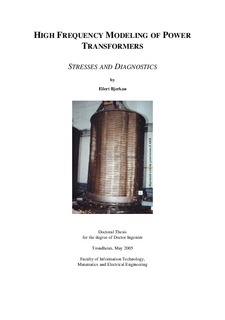| dc.description.abstract | In this thesis a reliable, versatile and rigorous method for high frequency power transformer modeling is searched and established. The purpose is to apply this model to sensitivity analysis of FRA (Frequency Response Analysis) which is a quite new diagnostic method for assessing the mechanical integrity of power transformer windings on-site. The method should be versatile in terms of being able to estimate internal and external overvoltages and resonances. Another important aspect is that the method chosen is suitable for real transformer geometries. In order to verify the suitability of the model for real transformers, a specific test-object is used. This is a 20MVA transformer, and details are given in chapter 1.4.
The high frequency power transformer model is established from geometrical and constructional information from the manufacturer, together with available material characteristics. All circuit parameters in the lumped circuit representation is calculated based on these data. No empirical modifications need to be performed. Comparison shows capability of reasonable accuracy in the range from 10 kHz to 1 MHz utilizing a disc-to-disc representation. A compromise between accuracy of model due to discretisation and complexity of the model in a turn-to-turn representation is inevitable.
The importance of the iron core is emphasized through a comparison of representations with/without the core included. Frequency-dependent phenomena are accurately represented using an isotropic equivalent for windings and core, even with a coarse mesh for the FEM-model. This is achieved through a frequency-dependent complex permeability representation of the materials. This permeability is deduced from an analytical solution of the frequency-dependent magnetic field inside the conductors and the core.
The importance of dielectric losses in a transformer model is also assessed. Since published data on the high frequency properties of pressboard are limited, some initial measurements are done on impregnated pressboard at different temperatures and moisture-levels. Tanδ is found to be twice the corresponding value for impregnated paper at frequencies from 50 kHz to 1MHz. Moisture has a minor effect on the losses when frequency approaches 1MHz. Service-aged paper (impregnated) is also tested in order to investigate other ageing-effects than produced water, but the test show the same decreasing influence at higher frequencies as impregnated pressboard with moisture added. The following main conclusions were drawn from this work:
• A simple, analytical approach cannot be used to build a versatile high frequency power transformer model. The reason being mainly the lack of a proper representation of the iron core, since a FEM-representation without the core did not increase coherence to measurements significantly.
• A proper representation of the iron core is very important for the calculation of inductances. Losses mainly originate from the core at intermediate frequencies (10-200 kHz), and not only from eddy currents in the windings as traditionally assumed. The permeability seem to be of less importance as long as it is well above permeability for oil, since the internal resonances mainly depends on the leakage inductances. The core leg equivalent is important for the leakage field and determines the leakage inductances and winding losses.
• Using a frequency-dependent complex permeability in a FEM-simulation makes possible an accurate representation of core and windings using a coarse mesh. If coating resistivity is sufficiently low to create interlaminar currents/ losses, the iron laminates should be represented by a 2-dimensional complex permeability. Coating parameters are seldom available.
• Dielectric properties of power transformer insulating materials depend on frequency, temperature, moisture, ageing and pressure. Temperature has minor influence on FRA-signatures, other parameters have practically no influence.
• Impulse- and resonant overvoltages both internally and on terminals can be analysed using this method with sufficient accuracy, provided the discretisation of the winding is sufficiently refined regarding the frequencies involved. Since terminal behaviour is given by the internal geometry and material parameters, it is assumed that internal behaviour is related to the accuracy of the terminal behaviour.
• FRA sensitivity to axial displacement is 1.2% of total axial height. The sensitivity to radial deformation (forced buckling) is found to be a buckling depth of 9% of the radius of the winding. Turn-to-turn short-circuits could not be modeled correctly since the lumped elements includes several turns. Disc-todisc short circuits are easily detected. Axial bending is not detectable. Detection of loose windings and aged insulation is improbable and will be dependent on the available sensitivity (mainly related to the repeatability of the measurements and the reference utilized for comparison).
The contributions in this work relates to different topics such as; Frequency-dependent iron core representation in FEM, study of interlaminar currents and its effect on the internal magnetic field, characterization of high frequency dielectric properties of impregnated pressboard and service-aged impregnated paper, procedure for evaluation of internal/external overvoltages, and finally sensitivity guidelines for the application of FRA to mechanical deformations. | nb_NO |
